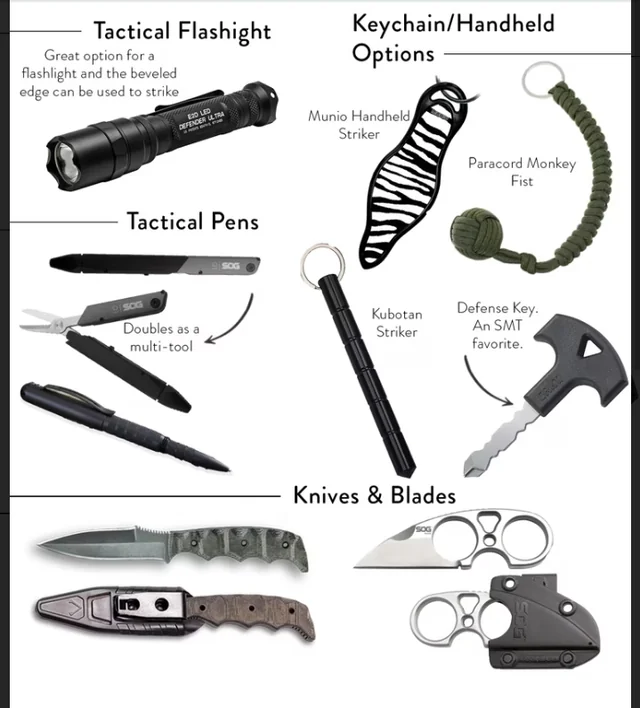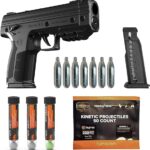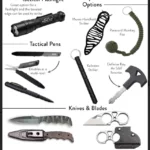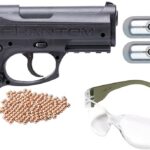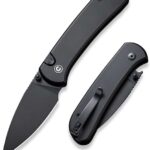Self-defense awareness is a crucial aspect of personal safety and many individuals prioritize legal self-defense weapons in the USA. Understanding the legalities of self-defense weapons is also critical. In the United States, where personal security is a major concern for many people, knowing your legal self-defense options is critical.
It’s important to be ready for emergencies in an unpredictable world. Self-defense awareness includes both being aware of possible threats and knowing how to defend oneself in different circumstances. It involves being aware of one’s surroundings, identifying possible threats, and having the necessary resources or information to react appropriately.
read also: Exploring the Viability of BB Guns for Self-Defense
Understanding Legalities Surrounding Self-Defense Weapons
When it comes to self-defense, legality plays a pivotal role. Laws regarding self-defense weapons vary across states in the USA. It’s crucial to comprehend the legal framework surrounding the possession and use of self-defense tools to ensure compliance and avoid legal ramifications.
Understanding the specific regulations imposed by federal and state laws regarding the ownership, purchase, and use of various self-defense weapons is imperative. This includes comprehending restrictions based on weapon types, age requirements, background checks and permits necessary for lawful possession.
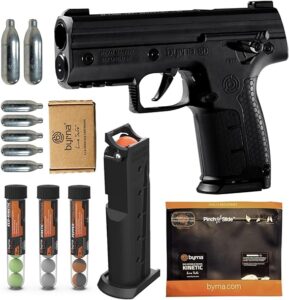
Overview of Legal Self-Defense Weapons
When considering self-defense in the USA, a variety of legal options exist, catering to diverse preferences and needs, these weapons span different categories, from firearms to non-lethal and melee options.
Firearms
- Handguns: Handguns are a popular choice for self-defense due to their portability and ease of use. They come in various calibres and styles, offering options suited to individual preferences.
- Shotguns: Known for their stopping power, shotguns are effective at close range. They come in different gauges and styles, making them versatile for various defense scenarios.
- Rifles: Rifles provide accuracy and range, making them suitable for defense situations where a longer reach is needed. They vary in calibre, action, and design.
Non-Lethal Weapons
- Pepper Spray: Pepper spray is a widely used non-lethal option, causing temporary discomfort and impaired vision when sprayed on an attacker. It comes in different formulations and spray patterns.
- Tasers and Stun Guns: Tasers and stun guns use electric shocks to temporarily incapacitate attackers. They differ in their mechanisms and power levels, offering choices for self-defense purposes.
- Tactical Pens: Tactical pens serve a dual purpose as a writing instrument and a self-defense tool. They are discreet and designed to cause injury when used in defense situations.
- Personal Alarms: Personal alarms emit loud sounds when activated, attracting attention and potentially deterring attackers. They are compact and easy to carry.
- Self-Defense Keychains: Keychains equipped with defensive features like pointed ends or pepper spray can serve as discreet self-defense tools.
Melee Weapons
- Knives: Knives come in various styles and sizes, offering a versatile self-defense option. However, their use requires a certain level of skill and understanding of legal restrictions.
- Batons: Batons provide a striking defense option, commonly used by law enforcement. They are available in expandable or fixed forms.
- Martial Arts Tools (Kubotan, Nunchaku): These specialized tools, like the Kubotan or Nunchaku, require training but offer effective defense options in skilled hands.
Federal and State Regulations on Self-Defense Weapons
Federal Laws and Restrictions
Federal laws in the USA govern certain aspects of self-defense weapon ownership and usage. The Second Amendment of the United States Constitution protects the right to bear arms, yet federal laws impose restrictions. Regulations encompass criteria for firearm purchases, background checks through the National Instant Criminal Background Check System (NICS), and bans on certain weapons or accessories.
State-Specific Regulations
- Variations in Permissible Weapons by State: State laws exhibit significant variability regarding permissible self-defense weapons. Each state holds distinct laws regarding firearms, non-lethal tools, and melee weapons. Some states may have stricter regulations on certain types of firearms or accessories, while others might allow wider usage.
- Concealed Carry Laws and Permits: States have diverse regulations regarding concealed carry permits. Some states issue permits with relatively lenient criteria, while others have stringent requirements, including training mandates or specific reasons for carrying a concealed weapon
Criteria for Legal Self-Defense Weapon Ownership
Age Restrictions
Legal ownership of self-defense weapons in the USA often comes with age restrictions. For instance, the minimum age to purchase firearms varies by state, typically ranging from 18 to 21 years old. Non-lethal options like pepper spray may have a lower age requirement for possession.
Background Checks and Permits
Background checks are a standard procedure for purchasing firearms. The National Instant Criminal Background Check System (NICS) examines an individual’s criminal history and other factors. Some states also require permits for firearm possession or concealed carry, involving additional background scrutiny and, in some cases, mandatory training.
Restrictions on Felons and Individuals with Certain Convictions
Felons and individuals with specific convictions face restrictions on owning self-defense weapons. Federal law prohibits firearm possession by felons, those convicted of domestic violence, and individuals with certain mental health conditions.
Factors to Consider When Choosing a Self-Defense Weapon
Effectiveness in Different Scenarios
The effectiveness of a self-defense weapon varies based on the situation. Firearms offer strong deterrence but require accuracy and training. Non-lethal options like pepper spray are effective in close encounters, while melee weapons like knives or batons demand proximity and skill.
Ease of Use and Training Required
Consider the level of training needed to wield a chosen weapon effectively. Firearms necessitate proficiency in handling and safety. Non-lethal tools typically require minimal training, while melee weapons often demand more practice and understanding.
Portability and Concealability
The portability and concealability of a self-defense weapon are critical. Firearms might be less concealable, but they offer significant power. Non-lethal options and compact melee weapons provide portability and discretion.
Legal Implications and Restrictions
Understanding the legal implications of owning and using a self-defense weapon is paramount. Laws vary by state, impacting the choice and use of specific weapons.
Tips for Safe and Responsible Use of Self-Defense Weapons
Understanding Proper Handling and Storage
Proper handling and storage of self-defense weapons are crucial for safety. Firearms should always be treated as if they were loaded and stored securely, away from unauthorized access. Non-lethal tools and melee weapons should be kept in easily accessible yet safe locations.
Training and Familiarization with the Weapon
Acquiring adequate training and becoming familiar with the chosen self-defense weapon is essential. For firearms, regular practice and training ensure proficiency. Non-lethal options and melee weapons also benefit from practice to ensure effective use in high-stress situations.
Legal Awareness and Understanding of Self-Defense Laws
Being well-versed in self-defense laws is imperative. Understanding the legal framework surrounding the possession and use of self-defense weapons, including where and when they can be carried or used, helps individuals avoid legal complications.
Frequently asked questions related to weapons
What weapon is illegal in the US?
Certain weapons are illegal to possess in the United States due to federal and state regulations. Examples include fully automatic firearms not registered under the National Firearms Act, explosives, grenades, and certain destructive devices like bombs or missiles. Additionally, brass knuckles, switchblade knives, and firearms with modified serial numbers are prohibited in many states.
What should you carry for self-defense?
Choosing a self-defense tool depends on personal preference, comfort, and legality. Popular options include pepper spray, tasers, stun guns, handguns, or non-lethal tools like personal alarms. It’s essential to research and understands state-specific laws governing weapon possession and carry before selecting a self-defense tool.
Is it legal to own a minigun?
Owning a minigun in the US is highly regulated under federal law. While legal ownership is possible, it requires an extensive background check, the payment of a substantial tax, and approval from the Bureau of Alcohol, Tobacco, Firearms, and Explosives (ATF). Miniguns fall under the National Firearms Act’s restricted category due to their fully automatic nature.
What is the best personal protection weapon?
Determining the “best” personal protection weapon varies based on individual needs, comfort level, and legal considerations. Pepper spray is a widely recommended non-lethal option due to its effectiveness and ease of use. Additionally, handguns, when legally owned and properly trained, can provide a reliable defense. However, the “best” weapon should align with your comfort, proficiency, and the laws in your state regarding possession and carry.
Is the Mac 11 illegal?
The Mac 11, a compact submachine gun, falls under the National Firearms Act’s restricted category due to its fully automatic nature. Without proper registration, compliance with federal regulations, and approval from the Bureau of Alcohol, Tobacco, Firearms, and Explosives (ATF), owning or possessing a Mac 11 is illegal in most circumstances.
What state has the freest gun laws?
Several states in the US are known for having relatively lenient gun laws, including states like Arizona, Alaska, and Wyoming. These states often have fewer restrictions on firearm ownership, purchase, and carry, allowing individuals more freedom to exercise their Second Amendment rights. However, gun laws can vary significantly, and it’s essential to research the specific laws and regulations of each state.
What is the 333 rule for self-defense?
The “333 rule” isn’t a widely known or established concept in self-defense. Self-defense strategies often emphasize awareness, avoidance, and de-escalation. It’s crucial to assess situations and aim to create distance (or remove oneself) from potential threats within a reasonable timeframe, if possible.
What are the five rules of self-defense?
There isn’t a fixed set of universally accepted “5 rules” of self-defense. However, basic principles include awareness of surroundings, avoiding potentially dangerous situations, understanding legal implications, using proportional force, and seeking help or contacting authorities when needed.
What is the best weapon for home intruders?
Choosing the best weapon for home defense depends on personal comfort, training, and legal considerations. Firearms like shotguns or handguns are commonly considered effective. Non-lethal options such as pepper spray or a taser may also be viable choices.
What is the best non-gun self-defense?
When considering non-gun self-defense options, several effective tools exist. Pepper spray is a popular choice due to its accessibility, ease of use, and ability to incapacitate an attacker temporarily. Additionally, stun guns or Tasers deliver electric shocks, providing a non-lethal yet powerful deterrent. Tactical pens, personal alarms, and self-defense keychains equipped with features like pointed ends or alarms are discreet options for self-protection.
Is 9 mm enough to stop an intruder?
A 9mm handgun is a common choice for home defense due to its stopping power and manageable recoil. However, stopping an intruder depends on various factors, including shot placement, ammunition type, and the intruder’s intent or state. Proper training, adherence to legal guidelines, and understanding of the firearm’s capabilities are crucial.
What is the best non-gun for self-defense?
The best non-gun self-defense tool varies based on personal comfort, training, and legal considerations. Pepper spray stands out as a widely recommended option due to its effectiveness, ease of use, and legality in many areas. Stun guns, tactical pens, personal alarms, and self-defense keychains also offer viable non-lethal choices for self-protection.
Conclusion
Awareness of the wide variety of acceptable self-defense weapons available gives people the power to make wise decisions. Each category offers a variety of options to suit different needs and preferences, ranging from melee weapons to non-lethal options and firearms.
It is crucial to choose a self-defense weapon while staying within the law. Maintaining legal compliance helps people stay within the law’s bounds and prevents them from facing possible legal consequences. Comprehending the laws and regulations is just one aspect of responsible ownership; other considerations include safety, appropriate instruction, and safekeeping of selected self-defense tools.
